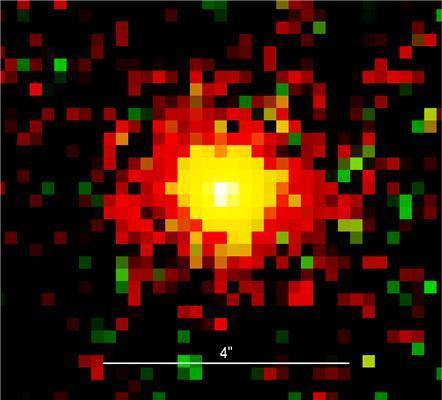Astronomer Tomotsugu Goto from the University of Hawaii and his colleagues discovered a giant galaxy surrounding a large black hole at a location farther away from Earth than humans have ever known. This galaxy, at a distance of 12.8 billion light-years, is about the size of the Milky Way and contains a great black hole that has at least a billion times as much matter as our Sun.
Scientists will publish their findings in this month's Monthly Notices of the Royal Astronomical Society.
Dr. Goto said: 'Surprisingly, such a giant galaxy has existed since the universe was only 1/6 of the current age, and the galaxy contained a massive black hole that was larger and bigger. 1 billion times our Sun. This galaxy and black hole must have formed very quickly in the early universe. '
Knowledge of host galaxies containing giant black holes plays an important role in understanding the secrets of galaxies and black holes' evolutionary process. Until now, the study of host galaxies in distant cosmic regions has been extremely difficult due to the glare from the surrounding black hole, making it difficult for astronomers to observe the light emitted from The host galaxy is inherently faint because of the great distance.
Unlike small-sized black holes that form when a large star dies, the source of the giant black holes remains an open question. The hypothesis is now being considered as a giant black hole created when several medium-sized black holes merge. After formation, the great black holes often continue to grow due to their gravity absorbing matter from nearby objects.The energy released in this process is the source of the bright light surrounding the black holes.
 The QSO image (CFHQSJ2329-0301), the most distant black hole known to man. In addition to a light-colored (white) black hole in the center, the image also shows the surrounding galaxy (red). (Photo: Tomotsugu GOTO, University of Hawaii)
The QSO image (CFHQSJ2329-0301), the most distant black hole known to man. In addition to a light-colored (white) black hole in the center, the image also shows the surrounding galaxy (red). (Photo: Tomotsugu GOTO, University of Hawaii)
To observe this great black hole, the team used a red-sensitive pairing device called Charge Coupled Devices (CCDs) installed on the Suprime-Cam camera of the Subaru telescope located in Mauna Kea, pants Hawaii Island. Professor Satoshi Miyazaki from Japan National Space Observatory (NAOJ) is the main investigator on the design of this new CCDs device, and is a collaborator of the research project. He said: 'The markedly improved sensitivity of the new CCDs has yielded interesting findings.'
A thorough analysis of the collected data shows that 40% of the observed near-infrared light (at 9100 Angstroms wavelength) comes from the host galaxy itself, and the remaining 60% is from the cloud substance (nebula) illuminated by black holes.
Yousuke Utsumi, a member of the research team, said: 'We witnessed a great black hole and its host galaxy together. This discovery opens a new page for the exploration of the evolution of black holes and galaxies in the early universe. '
Dr. Goto is a member of the Japan Science Promotion Association (JSPS). He earned his doctorate at Tokyo University in 2003, worked at Carnegie Mellon University, Johns Hopkins University and Astronomy & Astrophysics Institute of JAXA, a similar Japanese government agency like NASA. He went to the University of Hawaii's Space Research Institute in 2008 to work with Dr. David Sanders to study star-like objects (QSOs) and infrared glowing galaxies.
In addition, the study participants included Dr. Hisanori Furusawa and Dr. Yutaka Komiyama from NAOJ.
Journal reference:
1. Goto T., Utsumi Y., Furusawa H., Miyazaki S. and Komiyama Y. A QSO Host Galaxy and its Lyman alpha emission at z = 6.43.Monthly Notices of the Royal Astronomical Society, 2009;(in press)
 Van Allen's belt and evidence that the Apollo 11 mission to the Moon was myth
Van Allen's belt and evidence that the Apollo 11 mission to the Moon was myth The levels of civilization in the universe (Kardashev scale)
The levels of civilization in the universe (Kardashev scale) Today Mars, the sun and the Earth are aligned
Today Mars, the sun and the Earth are aligned The Amazon owner announced a secret plan to build a space base for thousands of people
The Amazon owner announced a secret plan to build a space base for thousands of people